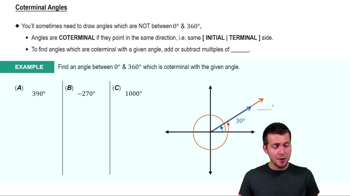Table of contents
- 0. Review of College Algebra4h 43m
- 1. Measuring Angles39m
- 2. Trigonometric Functions on Right Triangles2h 5m
- 3. Unit Circle1h 19m
- 4. Graphing Trigonometric Functions1h 19m
- 5. Inverse Trigonometric Functions and Basic Trigonometric Equations1h 41m
- 6. Trigonometric Identities and More Equations2h 34m
- 7. Non-Right Triangles1h 38m
- 8. Vectors2h 25m
- 9. Polar Equations2h 5m
- 10. Parametric Equations1h 6m
- 11. Graphing Complex Numbers1h 7m
1. Measuring Angles
Angles in Standard Position
Problem 37
Textbook Question
Find the measure of the smaller angle formed by the hands of a clock at the following times. 8:20
 Verified step by step guidance
Verified step by step guidance1
Step 1: Understand that the clock is a circle, which is 360 degrees, and it is divided into 12 hours. Therefore, each hour represents an angle of \( \frac{360}{12} = 30 \) degrees.
Step 2: Calculate the angle moved by the hour hand from the 12 o'clock position. At 8:00, the hour hand is at 8, which is \( 8 \times 30 = 240 \) degrees. At 8:20, the hour hand has moved further. Since each hour is 60 minutes, the hour hand moves \( \frac{30}{60} = 0.5 \) degrees per minute. Therefore, in 20 minutes, it moves \( 20 \times 0.5 = 10 \) degrees. So, the hour hand is at \( 240 + 10 = 250 \) degrees.
Step 3: Calculate the angle moved by the minute hand from the 12 o'clock position. At 20 minutes past the hour, the minute hand is at \( 20 \times 6 = 120 \) degrees, since each minute represents 6 degrees (\( \frac{360}{60} = 6 \) degrees per minute).
Step 4: Find the difference between the angles of the hour and minute hands to determine the angle between them. The difference is \( |250 - 120| = 130 \) degrees.
Step 5: Since the clock is a circle, the smaller angle between the hands is the minimum of the calculated angle and its supplement. Therefore, the smaller angle is \( \min(130, 360 - 130) \).
Recommended similar problem, with video answer:
 Verified Solution
Verified SolutionThis video solution was recommended by our tutors as helpful for the problem above
Video duration:
4mPlay a video:
Was this helpful?
Key Concepts
Here are the essential concepts you must grasp in order to answer the question correctly.
Clock Angle Formula
The clock angle formula calculates the angle between the hour and minute hands of a clock. It is given by the formula: Angle = |(30*hour - (11/2)*minutes)|. This formula accounts for the fact that the hour hand moves as the minutes pass, providing an accurate measure of the angle formed.
Recommended video:

Quadratic Formula
Understanding Clock Positions
To effectively use the clock angle formula, one must understand the positions of the hour and minute hands. The hour hand moves 30 degrees for each hour (360 degrees/12 hours), while the minute hand moves 6 degrees for each minute (360 degrees/60 minutes). Knowing these movements is essential for calculating the angle correctly.
Recommended video:

Drawing Angles in Standard Position
Smaller Angle Determination
When calculating the angle between the clock hands, it is important to determine the smaller angle formed. Since a full circle is 360 degrees, if the calculated angle exceeds 180 degrees, the smaller angle is found by subtracting it from 360 degrees. This ensures that the answer reflects the smallest angle between the two hands.
Recommended video:

Coterminal Angles

 5:50m
5:50mWatch next
Master Drawing Angles in Standard Position with a bite sized video explanation from Patrick Ford
Start learningRelated Videos
Related Practice












